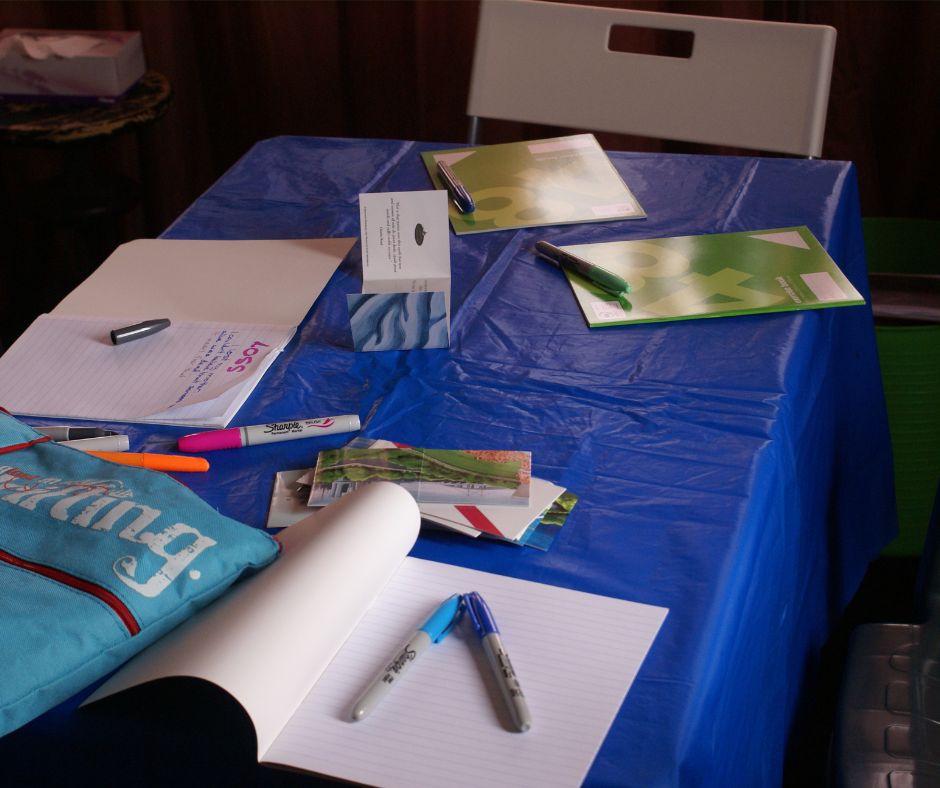
I often write about the way our brains suppress uncomfortable feelings. In this blog I am going to talk about how this relates to grief and how you can learn to sit with what is uncomfortable in your grief journey.
When you feel uncomfortable feelings, your brain responds in many ways.
The first way is you may consciously push the uncomfortable feelings aside. The more you do it, the easier it is to do next time. A lot of people learn to do this as they grow up. It is how we survive in a society that expects us to push our feelings aside in order to maintain the status quo.
But your brain acts subconsciously (without thinking) and unconsciously (below conscious awareness) as well to suppress the uncomfortable feelings.
Where does the brain hide these feelings? In your body. But those feelings don’t just stay there. They agitate to be heard. A lot of pain in the body actually comes from those suppressed, hidden feelings.
Imagine how hard it is to find those feelings and express them when your brain has been so efficient at hiding them!
This happens generally in life, but in this blog I am talking about how this happens with grief and makes it hard to process that grief and move forward in life.
What are the impacts of pain hidden in the body?
The raw pain that sits in your body has never had a chance to be processed. That pain can and does get triggered on occasion and then you are left feeling overwhelmed. Often the pain is never recognised for what it is. But its impacts are far reaching. They may even cause you to feel so overwhelmed with life that you are unable to move forward with your life.
What can I do about this pain?
Processing your pain daily is helpful. That is the ideal. In the early weeks of grief you may find daily too hard to do at first. But try when you can and eventually you will reach a point where you can process this pain daily.
How can I process this pain?
There are many ways to process the pain. I have a daily practice, which I teach in my “Paint Your Soul” workshops. If you have not explored what is hidden within yourself before, it may be more helpful for you to start with a different approach. This allows you to process the great volume of past hidden feelings.
Trust Your Intuition
I often have people telling me they don’t trust their intuition. This is because they have had bad experiences where they thought everything would work out and it didn’t. They often think they have listened to their intuition and it turned out badly. When asked to describe the experience in more detail, it emerges that their intuition was sending clear messages they weren’t heeding because their needs were drowning out the wise voice of their body.
Sit with your body
I teach people to take the time to sit with their feelings and focus on their bodies. Shutting down the brain’s chatter is challenging. But this practice, which is mindfulness, can be learned.
It is often better to learn from someone skilled with mindfulness. I often teach people who come to see me to practice mindfulness in their bodies.
Mindfulness needs to be practiced or it doesn’t work. When you are feeling relaxed and secure is a great time to learn how to tune into your body and listen. When you learn how to do that, it is more likely you can use mindfulness when you start to feel unsafe.
How do I use mindfulness to explore these hidden feelings?
A daily practice of mindfulness meditation and journalling is a great way to explore these feelings.
This involves meditating, listening to the body and writing in a journal the things you have observed.
This method helps you to listen to your body, understand the uncomfortable feelings hidden there and learn how trustworthy your intuition actually is.
How do I journal?
To do this practice, you need to commit to 15 minutes of practice a day.
It is best when you can be in a quiet place and undisturbed.
Getting up 15 minutes earlier in the morning is one way to achieve this if you can’t find space at any other point in the day.
What I have found when I did this practice was that the more I cleared subconsciously, the more my unconscious mind released for processing.
Sitting With The Discomfort Journal
Before you start, you need something to write your notes in. You will find you won’t write a lot, but it is important to record what you need to. This allows you to see patterns, discover hidden feelings, see progress and be encouraged. An old exercise book is ideal for this.
You may like to set a timer for 15 minutes so that you will know when the time is up.
Step 1 – Clear the Space Around You
To do this step, you may like to play some relaxing music quietly in the background. This is useful if there are distracting noises within hearing range.
Sit quietly and focus on your breathing. Note when you breath in and when you breathe out.
Breathe in deeply so that your chest and belly rise. Then breathe out slowly.
Take a few minutes to breathe in and out, just noticing the feeling of your in and out breathe.
Now notice your body. Breathe into each area of your body and observe how it is feeling. Then breathe out any tension held there.
Once you feel you are relaxed, ask yourself how you are feeling today. Don’t push the answers, just allow them to come up. Don’t let the issues that may arise overwhelm you. It helps to identify what comes up as “the feeling of”. This helps to keep it more objective.
Step 2 – Choose a Problem
Now choose one problem you will focus on. Remember to be outside the problem, keeping it objective.
Notice where in your body you can feel this problem. What are you feeling in your body?
Note down without too much detail what and where you are feeling things.
Step 3 – Explore the Problem
After writing down your notes, come back to the breathing in and out, and feel into that part of the body that is housing the problem.
What word, phrase, symbol or image comes up when you sit observing this problem?
Allow yourself to sit for a while to allow something to come up. Don’t try too hard. Just allow what comes up to come up. If nothing comes up that is okay.
Stay with what comes up and allow it to develop. When you feel you have enough detail then write a description of this in your journal. This is your felt sense.
Step 4 – Matching the Felt Sense and Description
Go back to breathing in and out as you focus. Once you are focused bring up the feeling of the problem again and think about it with the words you used in your journal to describe it. Do you feel they were the right words? If your body experience of your problem changes then follow the new changes. If either the feeling or the description need to change then do that.
Keep exploring this until you feel your description is the right one.
Step 5 – Ask More Questions
Now that your description of your problem feels right, it is time to ask your sense of the problem to deepen.
Feel the part of your body where you sense the problem. Ask it what the significance of the problem is. Ask it if the problem has more to add.
One technique I often use is to ask the problem what it wants, what it needs and what will it feel like if it gets what it needs.
Keep asking it questions until you feel you have explored enough.
Step 6 – What Does Your Body Want to Give You?
This may not happen on your first go. It may be that you may not even be able to identify the problem or find it in your body.
Persevere. As you do this practice every day you will learn how to find these problems in your body and understand your body better. You will also get faster at exploring the problems. With practice, you will learn to trust your intuition.
For this final step just sit again with your breath and the awareness of the body part where the problem was hidden. Allow yourself to be aware of anything that comes up. You may observe images, symbols, words, colours or any way you gain an impression of what you are experiencing around your intuition and the problem.
Sit with whatever comes up.
Sometimes you feel emotionally there has been a major shift. Just sit with that as your body absorbs what has happened.
As you sit you may develop an understanding, or that may not come for some time.
When you open your eyes you can record any impressions you gained.
Sit quietly for a few minutes. Feel your feet on the floor. Wiggle your toes. Move your fingers. Stretch your arms above your head. Listen to the noises in the room and outside. Then when you are ready open your eyes and go about your day.
Daily Practice Leads to Results
It may take some time to gain understanding and insights and that is normal. As you practice every day, you will notice over time that things become clearer and with that comes understanding.
You will also notice that the uncomfortable feelings are not as uncomfortable as you thought they were.
How This Relates to Grief
A major aspect of grief is being able to experience the pain and understand it. It is in letting yourself feel the pain that you are able to process it. Processing involves the experience of pain and the giving of meaning to it. It also allows you to be able to move through life with the pain so that it is more manageable.
Sometimes This Practice is Better Learned From a Professional
If you are having trouble learning this practice. Or the pain is overwhelming and you can’t do it. I am experienced in teaching mindfulness, as well as being trained in Grief and Loss Counselling. You are welcome to make an appointment to see me so that I can help you with mindfulness, being able to sit with those uncomfortable feelings, and learning how to do the steps of the daily practice.
I can be contacted on nan@plentifulllifecounselling.com.au or 0409396608.
Can I Help?
If you would like to talk to me about how I can help you with learning to complete your Sitting With The Discomfort Journal, please contact me on 0409396608 or nan@plentifullifecounselling.com.au
If you would like to learn more, I write a regular newsletter with helpful information, tips, information on courses, and the occasional freebie. At the moment I have a free mindfulness meditation for anyone who signs up to my newsletter. This meditation offers a way to safely explore your feelings and learn to be okay with them. If you would like to subscribe please click on the link here: http://eepurl.com/g8Jpiz
